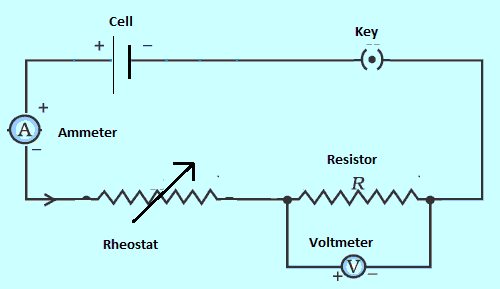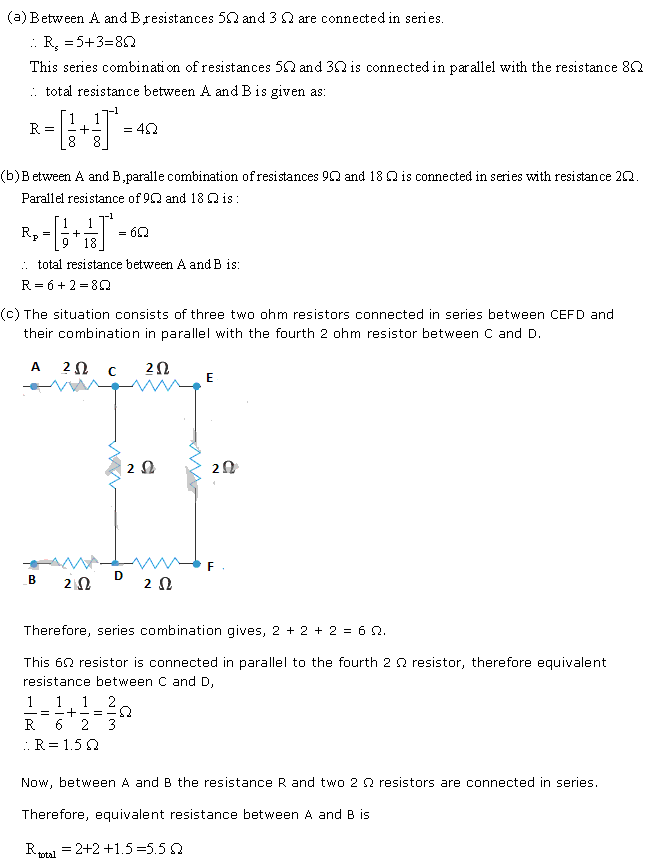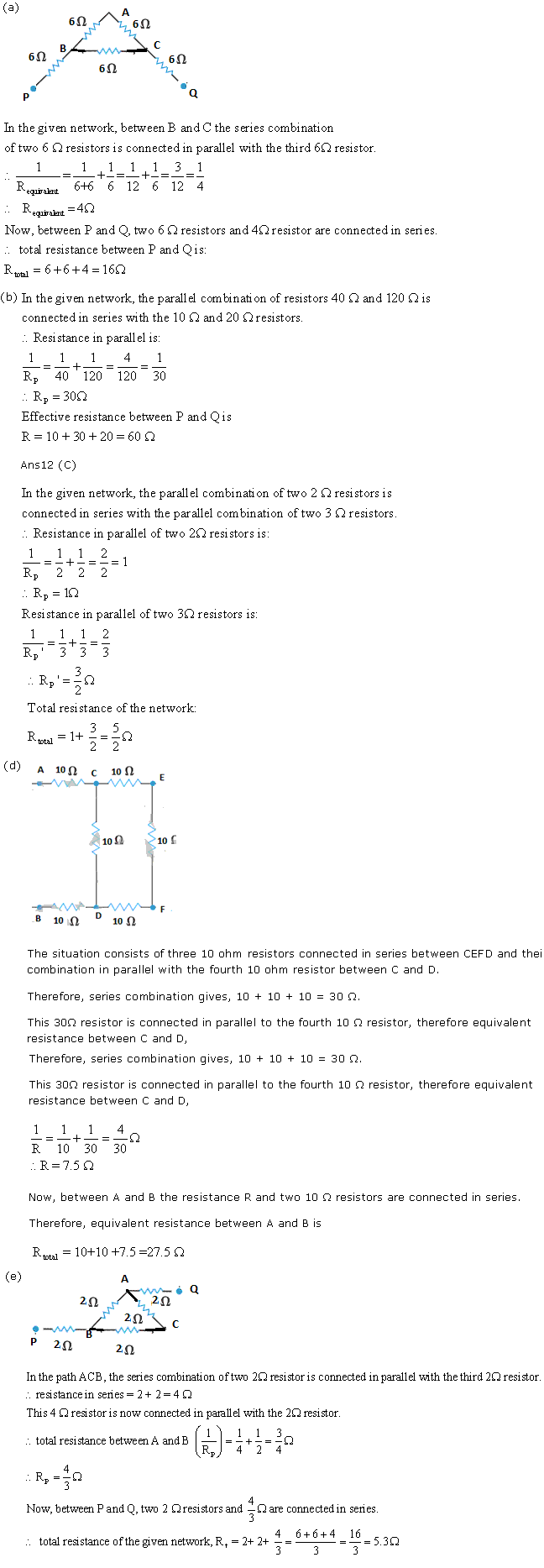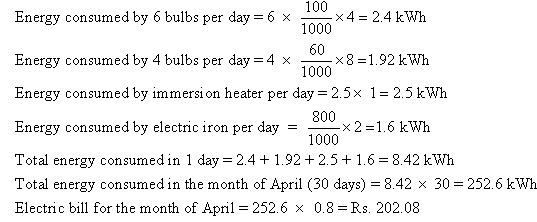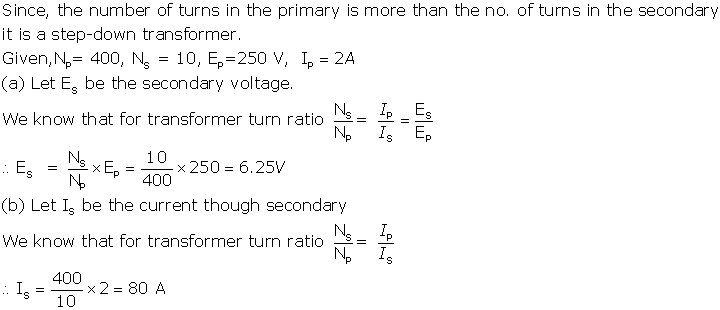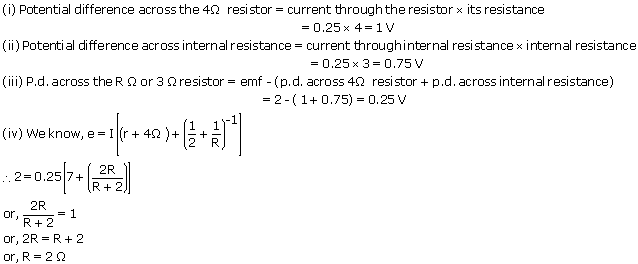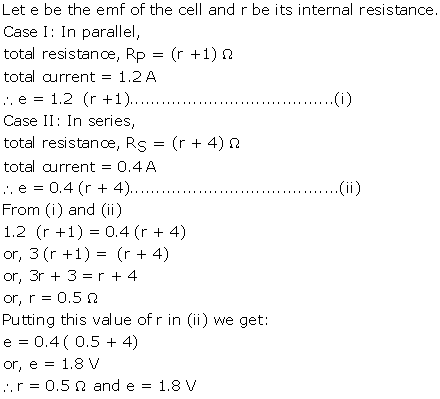Class 10 FRANK Solutions Physics Chapter 4 - Current Electricity - Exercises and MCQ
Study from Frank Solutions for ICSE Class 10 Physics Chapter 4 Current Electricity Exercises and MCQ to enhance your Physics capabilities. Learn to understand and work with circuit diagrams with our step-by-step explanations. Also, revise chapter definitions such as semiconductors, ohm, electromotive force etc. with our Frank textbook solutions.
Understand the construction and functioning of a filament bulb with TopperLearning’s ICSE Class 10 Frank Solutions and Selina Solutions. For chapter-specific self-assessments, look at our online practice tests which can be used as many times as you need.
Current Electricity - Exercises and MCQ Exercise 209
Solution 1
(i) 2/3 A
(b)
(ii) double in value
(c)
(iv) ohmic conductors
(d)
(iv) 6 ?
(e)
(ii) voltage
(f)
(i) protect the user from electric shock by short circuiting and consequently breaking the circuit.
(g)
(iii) A 13 ampere fuse is the most suitable rating to use
Solution 2
(b) (i) Coulomb: It is the unit of charge.
(ii) Ohm: It is the unit of resistance. The resistance of a conductor is said to be 1 ohm, if 1 ampere current flows through it, when the potential difference across its ends is 1 volt.
(c) Electromotive force: When no current is drawn from a cell, when the cell is in open circuit, the potential difference between the terminals of the cell is called its electromotive force (or e.m.f.).
(d) Semiconductors: Substances whose resistance decreases with the increase in temperature are named as semiconductors. E.g. manganin, constantan etc.
(e) Superconductors: Substance whose resistance decreases tremendously with the decrease in temperature and reaches nearly zero around absolute zero temperature are named as superconductors; e.g. lead, tin etc.
Solution 3
Limitations of Ohm's law:
1. Ohm's law does not apply to conductors such as diode, radio valves, metal rectifiers, where electricity passes through gases.
2. Ohm's law is applicable only when the physical conditions remain constant.
3. Ohm's law is applicable only when the temperature of the conductor is constant.
Solution 4
(i) Nature of conductor: different materials have different concentration of free electrons and therefore resistance of a conductor depends on its material.
(ii) Length of conductor: Resistance of a conductor is directly proportional to the length of a conductor.
(iii) Area of cross-section of a conductor: Resistance of a conductor is inversely proportional to the area of cross-section of the uniform wire.
(iv) Temperature of conductor: In general for metallic conductors, higher the temperature larger is the resistance.
Materials which allow electric charges to flow through them easily are known as conductors. E.g. metals and materials which do not allow the electric charge to flow through them are known as insulators. E.g. rubber, dry wood etc.
Current Electricity - Exercises and MCQ Exercise 210
Solution 5
Functions:
(A) Cell- It provides the potential difference in the circuit.
(B) Key- It serves as a switch in the circuit. It supplies or cuts off current as required.
(C) Ammeter- It measures the current in the circuit.
(D) Rheostat- It helps to change the resistance of the circuit without changing its voltage.
(E) Resistor- It provides a constant resistance in the circuit.
(F) Voltmeter- It measure the potential drop across the resistor.
Solution 6
Solution 7
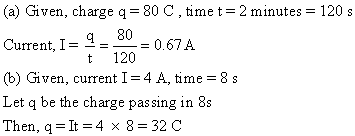
Solution 8

Solution 9
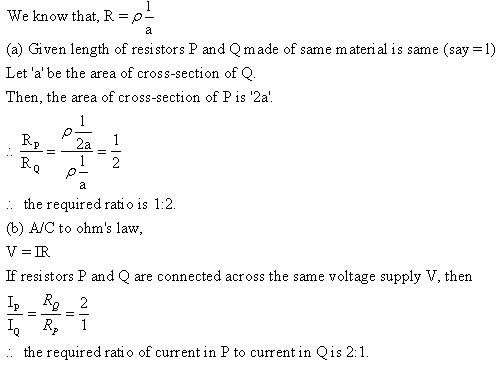
Solution 10
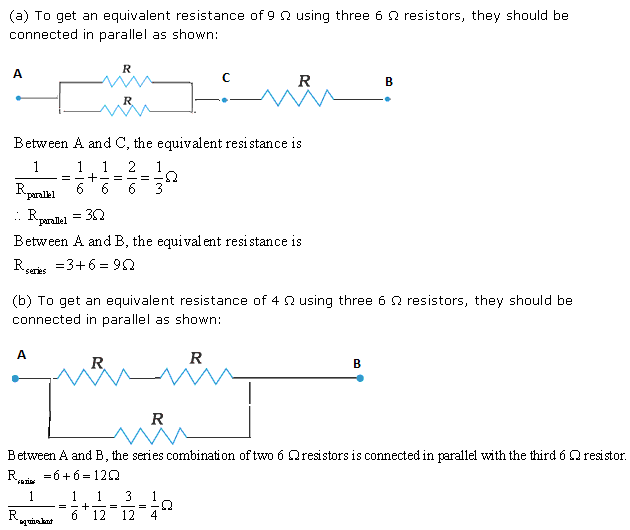
Solution 11
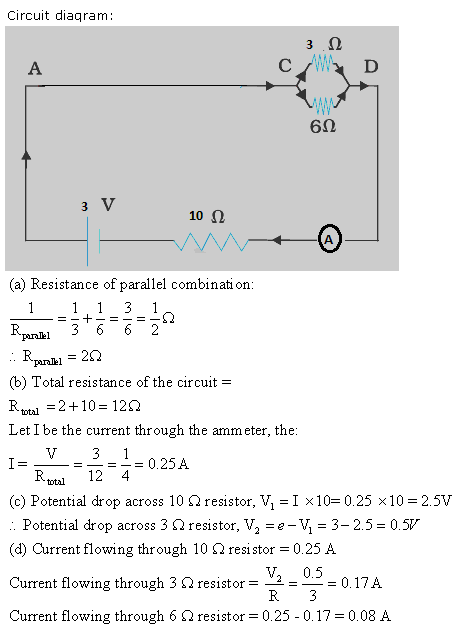
Current Electricity - Exercises and MCQ Exercise 211
Solution 12
Solution 13

Solution 14
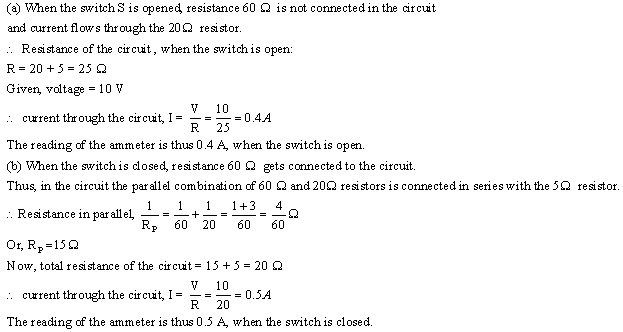
Solution 15
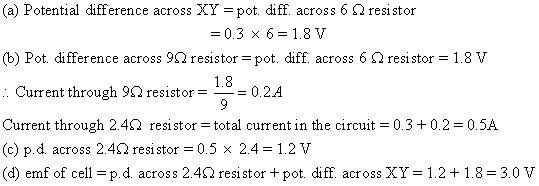
Current Electricity - Exercises and MCQ Exercise 212
Solution 16
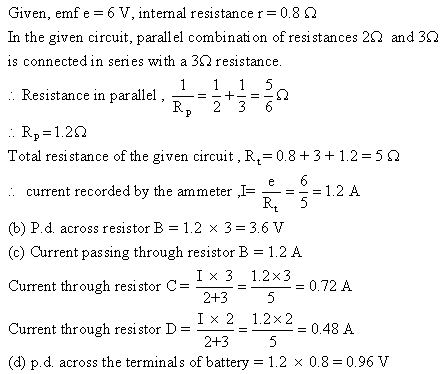
Solution 17

Solution 18
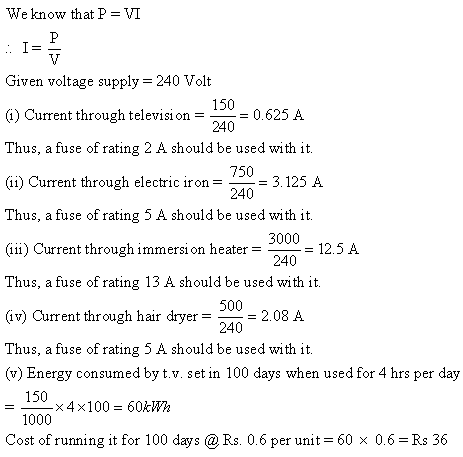
Solution 19
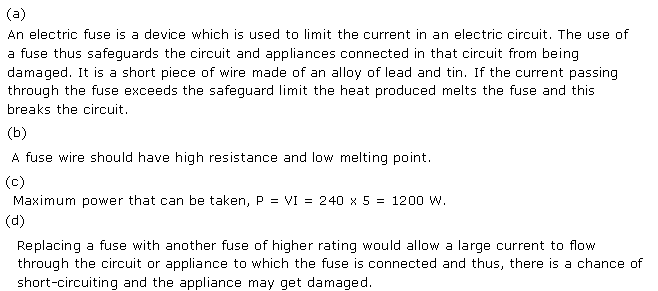
Solution 20

Solution 21

Solution 22

Solution 23
Blue wire or neutral wire should be connected to terminal B.
Green wire or earth wire should be connected to terminal A.
(b) No, current passes through the earth terminal i.e. terminal A in normal circumstances.
(c) The metal case of an electrical appliance is earthed so that in any case of accidental contact of live wire with the metallic body of the appliance, the earth wire would provide a safe and easy path for the electric charges to flow down to the earth which acts as very large sink. Thus, user is thereby protected from any fatal electric shock.
Solution 24
Current Electricity - Exercises and MCQ Exercise 213
Solution 26
Solution 25
List of materials used:
Light bulbs have two metal contacts, which connect to the ends of an electrical circuit. The metal contacts are attached to two stiff wires, which are attached to a thin metal filament. The filament sits in the middle of the bulb, held up by a glass mount. The wires and the filament are housed in a glass bulb, which is filled with an inert gas, such as argon.
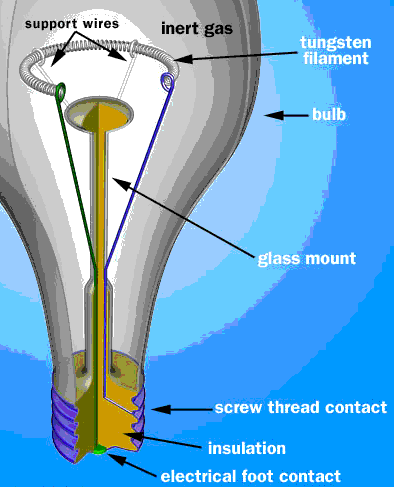
When the bulb is connected to a power supply, an electric current flows from one contact to the other, through the wires and the filament.
As the electrons zip along through the filament, they are constantly bumping into the atoms that make up the filament. The energy of each impact vibrates an atom -- in other words, the current heats the atoms up.
Metal atoms release mostly infrared light photons, which are invisible to the human eye. But if they are heated to a high enough level -- around 4,000 degrees Fahrenheit in the case of a light bulb -- they will emit a good deal of visible light.
Tungsten is used in nearly all incandescent light bulbs because it is an ideal filament material.
In a modern light bulb, inert gases, typically argon, greatly reduce this loss of tungsten. At extreme temperatures, the occasional tungsten atom vibrates enough to detach from the atoms around it and flies into the air resulting in its evaporation. In the rpesence of argon gas around it, the chances are that it will collide with an argon atom and bounce right back toward the filament, where it will rejoin the solid structure. Also since inert gases normally don't react with other elements, there is no chance of the elements combining in a combustion reaction.
Solution 27
(b) Fuse wire: Materials having high resistance and low melting point e.g. solder an alloy of lead and tin.
(c) Heating element: Materials having high resistivity and high melting point e.g. tungsten.
(d) Connecting wire of a power line: Materials having low resistance and non-corosive properties e.g. high tension wires.
(e) Earthing elements: Materials which are good conductors of electricity. Earthing elements are copper wire, copper plate, salt.
Solution 28

Solution 29

Solution 30
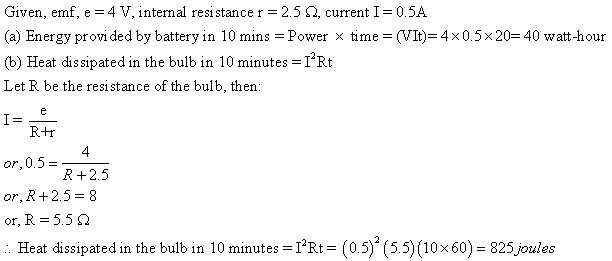
Solution 31
(b) Advantages of a parallel connection are:
(i) In parallel arrangement, each appliance works at the same voltage. For example, if several bulbs are connected in parallel, each bulb glows at the same voltage. Therefore, the glow of a bulb is unaffected if another bulb is switched on or off.
(ii) In parallel arrangement, if one bulb (or appliance
Solution 32
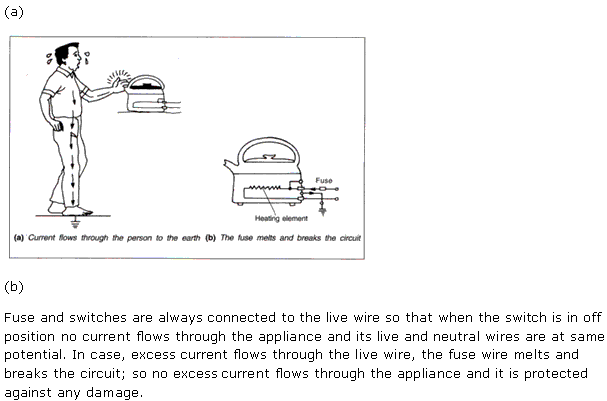
Solution 33
Solution 34
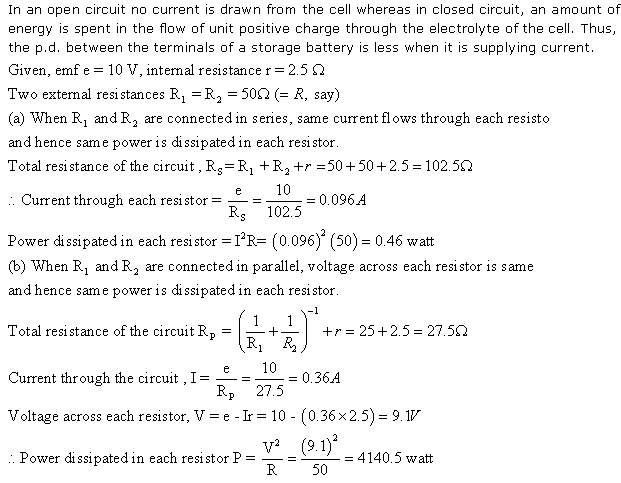
Solution 35

Solution 36

Solution 37
(a) A 13A fuse is the most appropriate value to use
Solution 38
(ii) Function of a step-up transformer is to increase the a.c. voltage and decrease the current.
(iii) No, a transformer cannot work on a d.c. source. With a d.c. source, there will be no change in magnetic flux linked with the secondary coil.
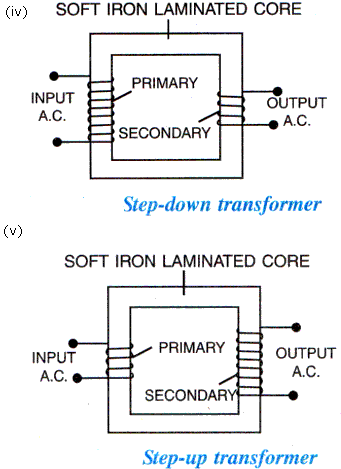
Solution 39
(ii) While closing the key, polarity at the end C of the coil Y will be north. There will be no polarity at the end C of the coil Y when the current becomes steady in the coil X.
(iii) (a) While the coil Y is moved towards the coil X, the polarity at the end C of the coil Y is north.
(b) While the coil Y is moved away the coil X, the polarity at the end C of the coil Y is south.
Current Electricity - Exercises and MCQ Exercise 214
Solution 40
(ii) On keeping the magnet still, the magnetic flux linked with the coil does not change and there is no deflection in the galvanometer, indicating that no current is flowing through the coil.
(iii) When the magnet is rapidly pulled out, there is again change in the magnetic flux linked with the coil and the galvanometer shows a deflection but this time in opposite direction, indicating that a current is flowing in opposite direction in the coil.
(b) If a more powerful magnet is used, deflection in the galvanometer will be large, indicating a greater amount of current.
Solution 41
(b) (ii) repulsion and attraction respectively
(c) (i) connecting a large resistor in series
(d) (iv) upwards and perpendicular to XY
(e) (i) 250 V
Solution 42
(b) Steel has high retentivity. Hence, after prolonged use even when the switch is off, it may retain some magnetic property and attract the armature.
(c) Using copper as a material for core will introduce eddy currents in the core and thus, interfere with the working of the bell.
Current Electricity - Exercises and MCQ Exercise 215
Solution 43

Solution 44
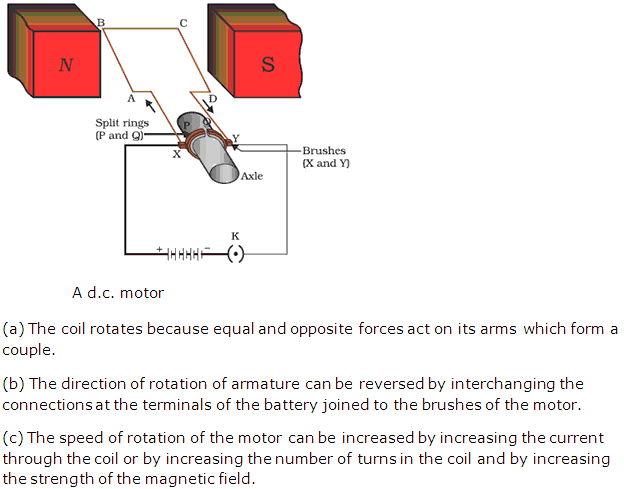
Solution 45
(ii) The current appears anticlockwise when viewed from end A because end A will form north-pole.
(iii) The galvanometer now deflects towards left.
(iv) No deflection is observed as there is no relative motion between the magnet and the coil.
Solution 46
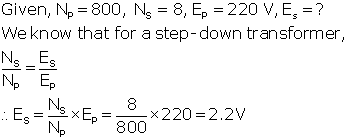
Solution 47
A moving coil galvanometer can be converted into a voltmeter by connecting a high resistance in series with the galvanometer.
Solution 48
A voltmeter is a high resistance device; hence it is connected in parallel.
Solution 49
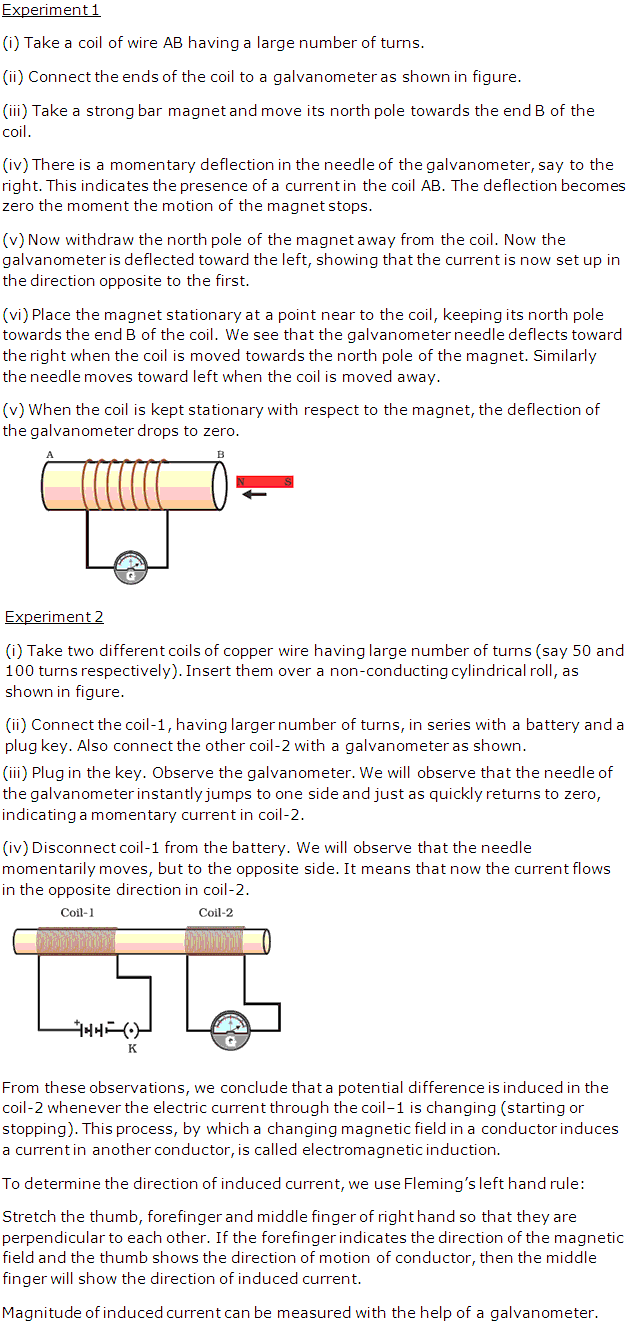
Current Electricity - Exercises and MCQ Exercise 216
Solution 50
(b) Introducing an iron bar in the tube, will increase the amount of induced current and the galvanometer will show a greater deflection.
Solution 51
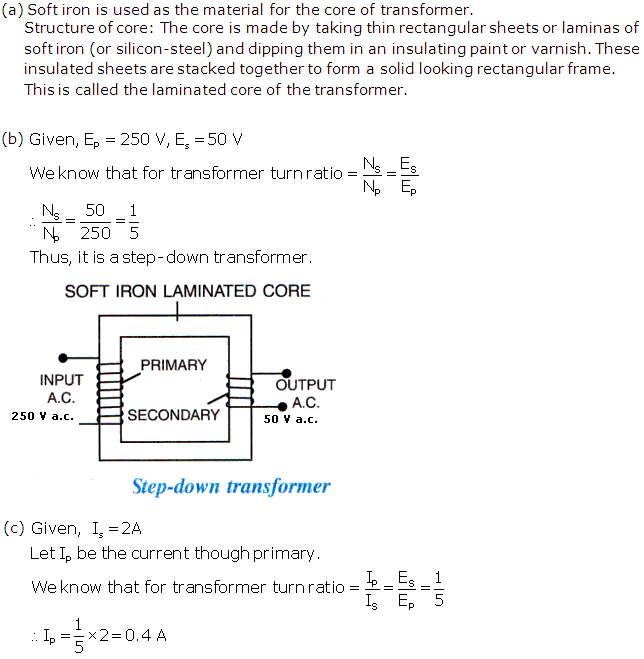
Solution 52
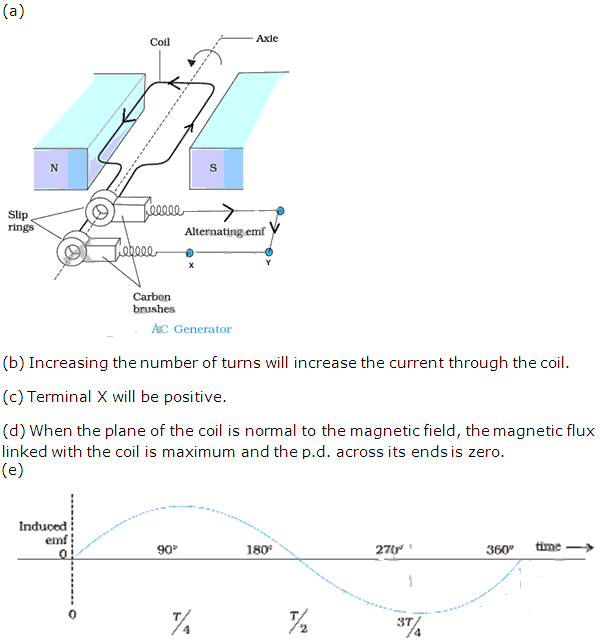
Solution 53
(a) Brightness of bulb will increase because increasing the number of turns in the secondary will increase the change in magnetic flux linked with the coil.
(b) Part X is the core of the transformer is removed, it shall become an open core and there shall be magnetic flux link loss; i.e. the entire magnetic field lines produced by the primary shall not be linked with the secondary.
(c) If the core of the transformer is made of copper due to the formation of eddy currents a lot of energy shall be lost.
(d) A transformer cannot be used with direct current (d.c.) since its working is based on the principle that when there is a change of magnetic field lines due to varying current of same in one coil, an induced varying current of same frequency flows in the other coil. If the current in one coil is constant (i.e. d.c.), no induced current will flow in the other coil since there will be no change in the magnetic field lines linked with the coil.
Current Electricity - Exercises and MCQ Exercise 217
Solution 54
Solution 56
(a) magnet - soft iron
(b) core- soft iron
(c) core- soft iron, magnet - steel
(d) core- soft iron, magnet - steel
(e) core-soft iron
Solution 57
Solution 55
(i) The core of the transformer is laminated which prevents the formation of eddy currents.
(ii) A closed soft-iron core is used which reduces the magnetic field link loss and hysteresis loss.
Solution 58
Solution 59
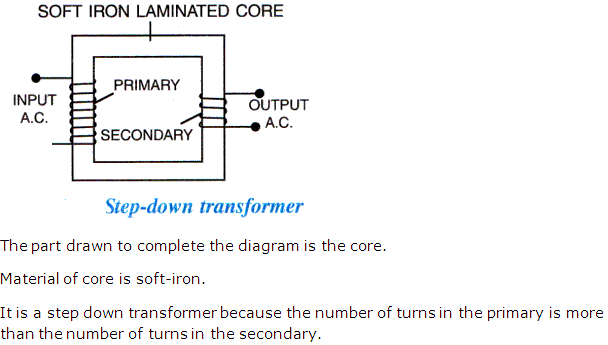
Solution 60
A transformer cannot be used with direct current (d.c.) since its working is based on the principle that when there is a change of magnetic field lines due to varying current of same in one coil, an induced varying current of same frequency flows in the other coil. If the current in one coil is constant (i.e. d.c.), no induced current will flow in the other coil since there will be no change in the magnetic field lines linked with the coil.

